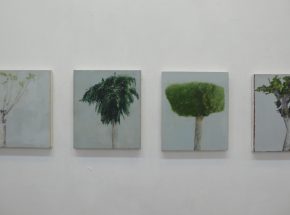

My goal is to study and master the traditional techniques of dyeing and printing on fabric, and to adapt them to my own purposes. Equally important, I realize that traditional and historical textiles served many functions, among them pure decoration, narrative documentation, and as markers of significant events and life passages. I try to acknowledge these roles in my own textiles in personal, contemporary ways.
All the steps of making an image on cloth – from concept to hanging – fascinate me, and I find it enhances my fabrics to take my concept along the path of process, connecting my thoughts through my hands to the cloth.
My work presents images of the natural world and the human experience in it, and I feel that the traditional textile techniques I use enhance the imagery. Shibori, Japanese stitch-resist dyeing, has a particularly exciting combination of technical challenge and variability, which results in richly evocative surfaces that seem akin to certain natural phenomena. The artist can control the pattern and its placement, but within the pattern there is a great range in the character of the individual mark. In addition, the craftsmanship required for shibori as well as other surface design techniques helps me to define my work as specifically fiber art, and to differentiate it from painting.
My recent work is the result of daily walks in the woods with my dog. For the past several years I have walked through all the seasons, in every kind of weather. These walks have become a kind of meditation, allowing me the time to truly observe and appreciate the seasonal cycles. I have created a panel for each month of the year, using such textile techniques as shibori, silkscreen and stitching.
Other recent work comprises a series of panels inspired by the fabric and architecture of Renaissance Italy and the real story of Pinocchio. These textiles were created in homage and response to the world-renowned story of Pinocchio, using silkscreen, shibori and collage, and incorporating motifs inspired by historical Italian fabrics. Pinocchio, by Carlo Collodi, is a cautionary tale full of dark humor and striking images, and these textiles present abstracted visual impressions of selected characters and events in the story. I have chosen my favorite moments from the original Pinocchio. These are of special interest to me because of the strong imagery conjured up by the language, and I have depicted, through abstraction, narrative and collage, my versions of the story’s characters, settings and events. The panels do not attempt to “tell” the story of the puppet’s adventures but instead to present slices of the story that to me are particularly striking.
